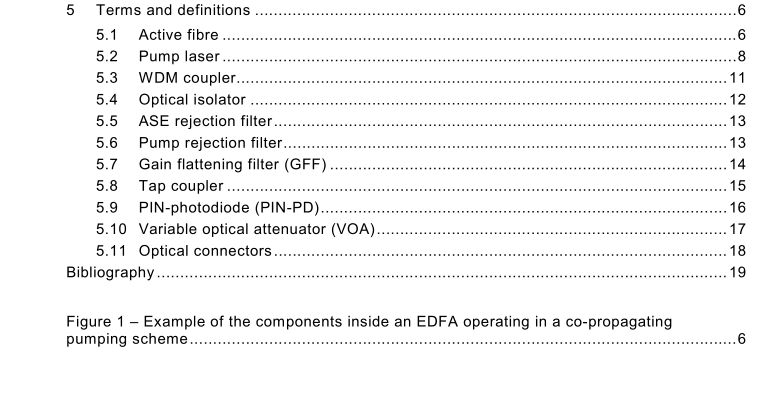IEC TR 61292-1:2009 pdf download – Optical amplifiers – Part 1: Parameters of amplifier components
1 ) The positive difference of the closest spaced wavelengths, one above and one below the peak wavelength λ peak , at which the spectral power density is 3 dB down from its peak value.
2) The difference of the half-power wavelengths can be determined as follows; since the laser may not have modes at these wavelengths, they may be obtained by interpolation.
3) Connect the tip of each mode to the tips of adjacent modes; draw a horizontal line 3-dB down from the peak power point.
4) The two or more intersection points define the half-power wavelengths. The maximum difference in half-power wavelengths is Δ λ fwhm . NOTE Refer to IEC 61 280-1 -3 for details.
5.2.6 wavelength stability rate of variation of pumping wavelength with respect to operating and environmental conditions
5.2.7 threshold current driving current at which the pump laser starts to lase. Practically, this value is specified as the crossing condition between the spontaneous emission and lasing regions
5.2.8 maximum allowed current maximum driving current which may cause irreversible damage to the pump laser. A current, derated from the absolute maximum rating, is generally applied
5.2.9 pump LD chip temperature temperature of chip to be controlled for normal operation, where performance of pump LD ensured NOTE The output power and operating wavelength are affected by laser chip temperature. Therefore ordinary pump LD module includes a TEC in order to maintain LD chip temperature. The temperature range of 25 ˚C ~ 45 ˚C is commonly specified by LD vendors. Previous generation chips are specified at 25 ˚C, and some more recent chips are specified to operate at 35 ˚C or 45 ˚C.
5.2.10 pump LD case temperature operative temperature range of LD case within which the pump laser module can be operated while still meeting all its specified parameter values, given in the relevant detail specification NOTE Power consumption of temperature controlled pump LD module with TEC features differs for various case temperatures, since TEC is operated to maintain LD chip temperature against various (high or low) temperatures. The case temperature also affects center wavelength and wavelength stability of pump laser with FBG wavelength stabilizer, since reflection wavelength of FBG is varied for its case temperature. Therefore pump LD case temperature is specified by LD vender to ensure normal operation of all the related performance. Most of LD module is specified for case temperature range around 0 ˚C ~ 75 ˚C.
5.2.11 chip temperature dependence of threshold current threshold current dependence on pump laser chip temperature
5.2.12 case temperature dependence of wavelength wavelength dependence of the center wavelength of the laser on the pump laser case temperature, expressed in nm/˚C
5.2.13 device reliability probability of performing required functions at specified operating and environmental conditions. The reliability of a pump laser is expressed by either of the following two parameters: mean time between failure (MTBF) or failure in time (FIT): MTBF is the mean period of continuous operation without any failure at specified operating and environmental conditions FIT is the number of failures expected in 1 0 9 device-hours at specified operating and environmental conditions
5.3 WDM coupler A WDM coupler is used to unify pump light with signal light and to guide combined light to active fibre. Thin film technology or tapered fused coupler technology is commonly applied to the WDM coupler.
5.3.1 WDM coupler signal insertion loss fraction of the optical power associated with the input signal and launched into the signal input port of the coupler which does not exit from the signal output port of the coupler, expressed in dB
5.3.2 WDM coupler pump insertion loss fraction of the optical power associated with the pump and launched into the pump input port of the coupler which does not exit from the signal output port of the coupler, expressed in dB 5.3.3 WDM coupler PDL maximum insertion loss variation due to the change of the input light state of polarization, expressed in dB. This term is defined for both signal input port and pump input port
5.3.4 WDM coupler signal reflectance fraction of the optical power associated with the input signal which is reflected by the signal from input port of the coupler, expressed in dB
